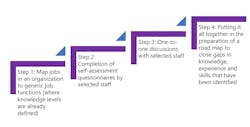Good process safety in any organization requires specific knowledge, experience and skills. These building blocks of process safety lie, of course, mainly with your organization’s staff. So, how do you know if you have the right knowledge, experience and skills in your organization? Who exactly should know what about process safety? These questions can be challenging to answer, but there are structured approaches available that can be used to answer them.
In this article, we look at an approach to assuring that there is sufficient process safety knowledge, experience and skill in your organization and how it is possible to assess this so that supportive action can be taken if necessary. We term this process safety assurance assessment. Such an assessment is not about looking for individual failings; in fact, it is the opposite. It is all about ensuring there are no functional or level gaps or omissions that no one has spotted, and then providing support where needed to fill the gaps.
PROCESS SAFETY CAPABILITY—AND WHAT YOU NEED
Process safety, of course, is all about preventing fires, explosions and accidental chemical releases in industrial facilities—the major events we read about with foreboding in the press. Process safety requires a disciplined framework for managing the integrity of operating systems and processes that handle hazardous substances. As such, it relies on good design principles, engineering and operating and maintenance practices.
In fact, it relies on proper application of regulations, guidelines, best practices and more. But, of course, it is people who have to be relied on to make sure that whatever systems are employed to manage the process safety risks are properly applied and maintained. It is our contention that achieving good process safety outcomes requires specific knowledge, experience and skills within an organization—and what’s more, these capabilities should be distributed widely throughout the people that make up the organization—from the board, through managers, supervisors, operational staff and others.
As an owner or safety director of an industrial facility you are likely relying on the working together of many individuals to ensure process safety is properly applied in your facility. But how do you know you have the right knowledge, skills and experience among the many “factors” in the process safety field? How do you ensure that there are no functional gaps, skills gaps, or knowledge gaps? The answer could well come from an independent assessment of process safety application, performed by assessors who have ”been there” and ”done that” and have seen how others deal with ensuring the completeness of the plethora of skills, knowledge and experience required to achieve good levels of process safety.
WHO SHOULD KNOW WHAT ABOUT PROCESS SAFETY?
In our opinion, process safety awareness needs to permeate an organization from top to bottom. That does not mean to say that everyone needs to be a process safety expert. But it does mean that at least a very basic understanding of process safety is beneficial pretty much everywhere. Get it right and this basic awareness will help develop the right culture within an organization which can lead to extra vigilance and even an appreciation that the company “cares.”
Clearly different job functions require different types of process safety knowledge, but simply employing dedicated process safety staff, while important, is not the only consideration. Such staff will be expected to gain a strong understanding of process safety, but it is clear that simply employing staff dedicated to process safety does not guarantee the safety of the people and your facility. Process safety is a big field, and any one person is unlikely to have all the skills, experience and knowledge required. In any case, process safety staff are just one “cog in the wheel” that can make a facility safe, and a degree of assurance is required at many levels in an organization.
Here are a few examples of different job functions along with an outline of the sorts of awareness and skills they should have. Notice that the lists starts with the executive board:
- The executive board should understand the bigger picture of likelihood and consequences of incidents, emergency preparedness, main legislative responsibilities, and how the culture they set influences safe behavior.
- Engineering staff need detailed knowledge of safety in design, codes and standards, process and operational matters, contractor management, and more.
- Operating staff, including contractors, need a sufficiently broad understanding of process safety to be able to perform their jobs safely. That would include application of incident reporting, emergency procedures, operations and hand-over, hazard identification and awareness, and more.
- It even benefits the organization if staff in support functions such as finance and HR understand the importance of process safety at a basic level—such as the impact of change management and the importance of incident reporting.
- A range of staff functions have influence on process safety in practice, and different staff functions require different levels of knowledge, experience and skills in process safety.
- Fortunately, over the years work has been done to determine numerically quantified knowledge, experience and skill levels for different job functions. Additionally, organizational evaluation programs have been developed that can be applied to most types of industrial facilities.
A STRUCTURED APPROACH TO ASSURANCE
A structured process safety assurance assessment (see Figure 1) begins with job mapping to generic job functions where pre-determined knowledge, experience and skills levels are available. This is undertaken by process safety and other staff together with an experienced assessor. Sometimes this initial task will reveal missing job functions right at the start.
The second task will involve the relevant personnel identified in the job mapping exercise. Typically, staff will be invited to complete self-assessment forms in which they are invited to indicate their own experience levels in different areas.
Armed with the self-assessments and job mapping results and levels expected, the next stage will usually involve a series of meetings to evaluate process safety roles through structured one-to-one discussion. This makes it possible to explore in more detail the identified areas where potential gaps exist, and to develop programs to overcome them.
In practice, it is the discussion with individuals that provides the opportunity to explore the strengths and any potential gaps and to assure that all skill areas required by the organization to run a safe plant are present and that nothing has been overlooked. You’re looking for both unallocated areas of responsibility as well as levels of knowledge, experience and skills.
IS PROCESS SAFETY ASSURANCE ASSESSMENT APPROPRIATE FOR YOUR ORGANIZATION?
The small company: With small companies, there are fewer people to hold the necessary knowledge, experience and skills, and individuals are often required to wear a few different hats. This means gaps may more readily occur and that identifying these is that much more important. Additionally, management of the identified knowledge, experience and skills is critical too because it is necessary to ensure that as some staff leave and others join the organization, no gaps are created—and that knowledge and skills are kept up to date.
The large corporation: In large organizations, the challenges are more likely to revolve around knowing what is happening at facilities that are geographically distant or even in other countries where process safety culture and standards may be different. Process safety assurance assessment work can bring reassurance to corporate executives, and highlight where effort can be targeted for best returns in process safety/risk reduction.
WHAT TO DO WITH THE RESULTS?
The output from a process safety assurance assessment should include strategies for filling any gaps in knowledge, experience and skills that have been identified. This can be presented as a roadmap toward process safety excellence.
At its simplest level, training may fill a gap, but other possible strategies include linking with other sites in an organization where the gaps are well filled or reviewing best industry-specific practices. It could also involve the use of mentors or arranging participation of selected staff in certain process safety activities, such as process safety audits or meetings to develop understanding.

